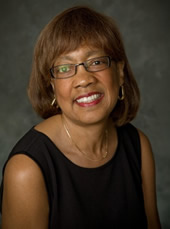Interest rising for Microloans: Pfeiffer’s Minyard
Charlotte Business Journal - by Laura Williams-Tracy Contributing writer
Pfeiffer University professor Rosemary Minyard’s career in the highest echelons of finance has evolved to an interest in the economics of poverty. One of the first African-American women to earn a Ph.D. in economics from Princeton University, Minyard spent her early career doing the inaugural work of the newly created Congressional Budget Office in 1976. She spent much of the 1980s at Merrill Lynch on Wall Street and took a job with the Federal Deposit Insurance Corp. in the late 1980s to help unravel the savings & loan crisis.
As an assistant professor of economics and finance at Pfeiffer University’s MBA program, Minyard is turning her focus to microfinance. That’s the practice of lending small sums to launch income-generating businesses. The concept, made famous by Bangladeshi banker and economist Muhammad Yunus, has only recently started to gain traction in the United States.
The discipline also aligns with Pfeiffer’s Methodist roots of promoting servant leadership. In September, Minyard hosted a colloquium on microfinance at the university, which attracted the interest of area churches.
“Microfinance is captivating to people from a charitable perspective because they see how a little bit of money can help the poorest of the poor get a leg up,” Minyard says. She recently discussed the subject with the Charlotte Business Journal; edited excerpts from that conversation follow:
How is microfinance different from a standard bank loan?
Microfinance is providing financial services for poor and low-income clients. Typically poor clients have no collateral. Microfinance is usually done by a firm that calls itself a microfinance institution, or MFI. That’s a broad term, but typically it is not a profit-maximizing institution.
Is microfinance a growing sector?
It’s not growing in the sense that it’s pushing out traditional bank loans. But it is growing in the sense that people realize these MFIs can accomplish some development goals in the undeveloped world in Latin America, Asia and Africa. It is still more of a charity-driven initiative than a banking initiative.
Who are the big microlenders?
That’s a hard question to get your arms around. An organization called the Microcredit Summit Campaign tried to measure it. They came up with 3,500 MFIs globally that are reporting their loans and getting audited by a third party. The Microcredit Summit Campaign did this measurement as part of a goal of reaching 100 million clients by 2006-07, and they did reach the goal.
Are any traditional U.S. banks making such loans?
I don’t think so. Microfinance is attracting a lot of donor capacity since Muhammad Yunus won the Nobel Peace Prize in 2006.
The poor are usually unattractive loan candidates because they have little collateral and entrepreneurial experience. Can lenders realistically expect a return?
Investors are taking an interest in microfinance because Yunus built his Grameen Bank into a multibillion organization owned by its borrowers. You mention the belief that the poorest people are a bad credit risk because they have no collateral. Our perception that the poor are a bad credit risk is wrong. Yunus proved the poor still make loan payments. Since inception, Grameen Bank has made $8.43 billion in loans with an average size of $100 and a term of six months. The bank’s loan-recovery rate is 98%. Yunus proved that poor people can still be a good credit risk.
Why don’t commercial banks make loans like these?
Because it’s too expensive for traditional banks to administer such small loans. Payday lenders lend to the poor, but we all know the interest rates they charge. We see groups like Goldman Sachs making contributions to MFIs as donations, but not as investments.
Is there evidence that microfinance is making a difference?
The Microcredit Summit Campaign’s latest report for 2008 shows there are 3,552 MFIs reaching 154 million clients, with 100 million of those clients being the poorest of the poor. Women and small, home-based businesses and day-care centers are the biggest benefactors.Ninety-seven percent of borrowers from Grameen Bank are women.
There are 38.8 million people in the United States living in poverty. Could microfinance loans be put to use here?
Yunus thinks it can. He has created Grameen America, and he’s taking the same methodology from Bangladesh. He’s competing with payday lenders but with much lower interest rates. One of the things he’s doing is that when borrowers pay their loans back to Grameen America, their performance gets reported to credit-reporting agencies. Poor people begin to build documentation of their good credit.
DETAILS, DETAILS
Name: Rosemary Minyard.
Position: Assistant professor of economics and finance, Pfeiffer University
Native: Hartford, Conn.
Neighborhood: Matthews
Family: Single
Education: New York University, B.A. in economics, 1970; Princeton University, master’s in economics, 1973; Ph.D. in economics, 1979; CPA
Career advice: Stay in school or keep learning and try to do what you love.
Last book read: The Race Beat, Gene Roberts and Hank Klibanoff
Favorite movie: Hotel Rwanda
Spare-time activities: Travel
Laura Williams-Tracy is a Charlotte-based free-lance writer who can be reached at laura@lwtcommunications.bz.

